Squash provides endless cooking possibilities, and you can’t compare its versatility to most vegetables.
Whether you’re baking, thinking of what to add to your stews, or need to make some creamy and rich soup, you’ll find a squash to fit your needs.
When shopping for squash, you may come across different squash colors.
Green squash is one of the types available in most grocery stores. These squashes can either be summer or winter varieties.
Our detailed guide lists some common types of green squashes, their characteristics, and what you can use them for in your recipes.
Table of Contents
17 Types of Green Squash
Here are seventeen common types of green squash:
1. Acorn Squash

Acorn squash is a winter squash with green skin and orange-yellow flesh.
The squash gets its name from its unique acorn-like shape. It’s one of the popular types of squash due to its sweet and nutty flavor.
Acorn squash is the perfect size for individual servings.
Although acorn squash is delicious when baking, you can also steam it or puree it and add it to your soups. You can also consume it raw.
2. Zucchini

Zucchini squash is a cylindrical type of winter squash picked when immature. It’s also referred to as courgette or marrow squash.
Zucchini goes well in most savory side dishes.
Zucchini’s neutral taste also means you can grill it, roast it, saute it or use it as a pasta substitute. You can also consume it uncooked.
3. ‘Green Eggs’
‘Green eggs’ is a type of squash that resembles zucchini. The difference is that ‘Green Eggs’ squash is fat, short, and looks like eggs.
This squash has deep dark green skin. It also grows on bushy vines.
4. ‘Bon Bon’ Squash
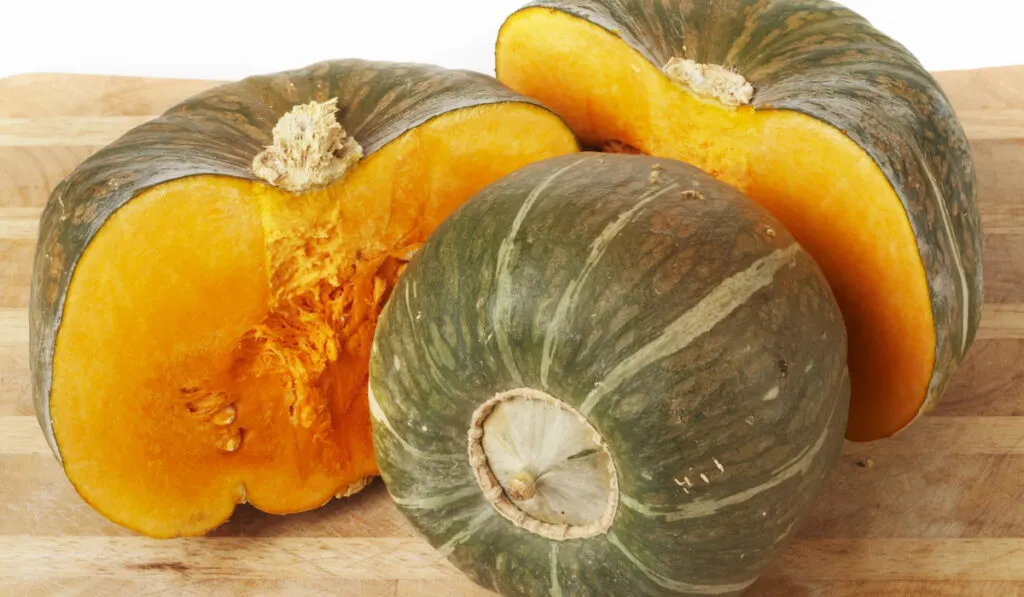
‘Bon Bon’ squash shares some similarities with buttercup squash. The only difference is the flesh is sweeter than that of the buttercup.
This squash is compact and has a round shape. Its skin is green and covered with pale green stripes.
This versatile squash allows you to bake it, steam it, roast it, or make soups with it.
5. Buttercup Squash
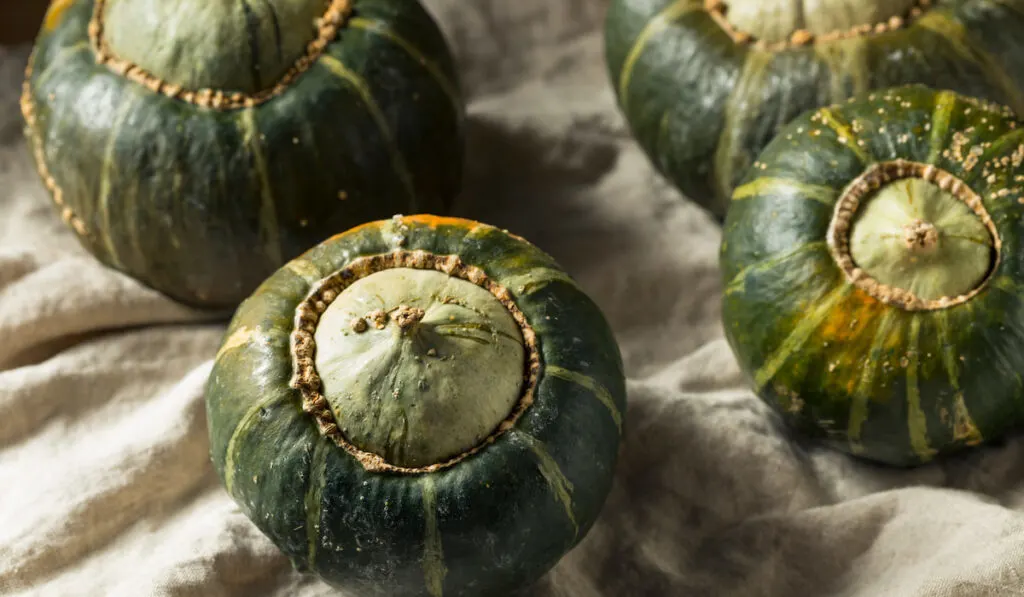
Buttercup squash is dense, round, and has dark green skin with some green stripes. Although its flesh is edible, it’s thicker and difficult to peel.
Its bright orange flesh is sweeter than butternut and can also be pureed, roasted, sauteed, and added to soups.
Buttercup squash’s creamy texture also makes it great for baking.
6. ‘Honey Bear’ Squash
‘Honey Bear’ squash is a type of acorn squash.
Gardeners find ‘Honey Bear’ squash easier to grow as they are tolerant to powdery mildew and produce a high yield.
7. Kabocha Squash
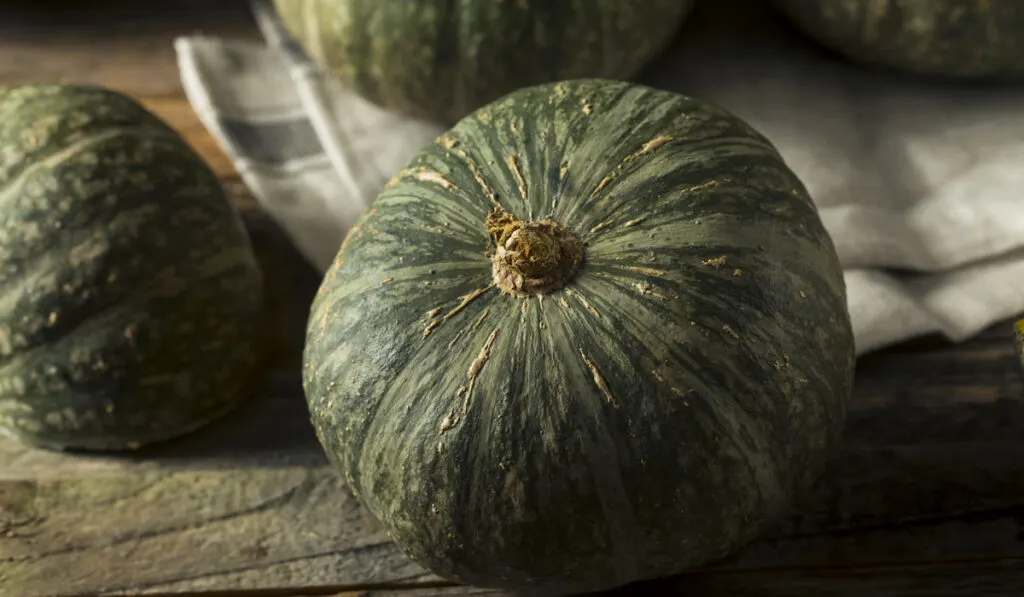
Kabocha squash, or the Japanese pumpkin, has dark green skin and yellow flesh. The squash resembles buttercup squash on the exterior and interior.
In Japanese cuisine, kabocha squash is often used in tempura batter thanks to its sweet taste and velvety texture.
It’s mainly grown for eating, and it’s perfect for baking and stuffing. Kabocha squash can also be roasted and eaten as a side.
You can also be puree it for soups.
8. Cousa Squash
Cousa squash is common in Middle Eastern cuisine.
The squash has an oval shape like that of spaghetti squash. Its green skin, seeds, and flesh are all edible.
If you’re looking for squash that adds that delicate flavor to your stews, soups, and stuffing, you should get cousa squash
10. Chayote Squash

Chayote squash looks like a pear, but its skin has ridges and folds.
It has bright green skin with firm white flesh. Unlike most squashes, the chayote squash has a mild flavor, which allows you to incorporate it into your stir-fries, stews, and salads or spiralize it into noodles.
10. Calabaza Squash
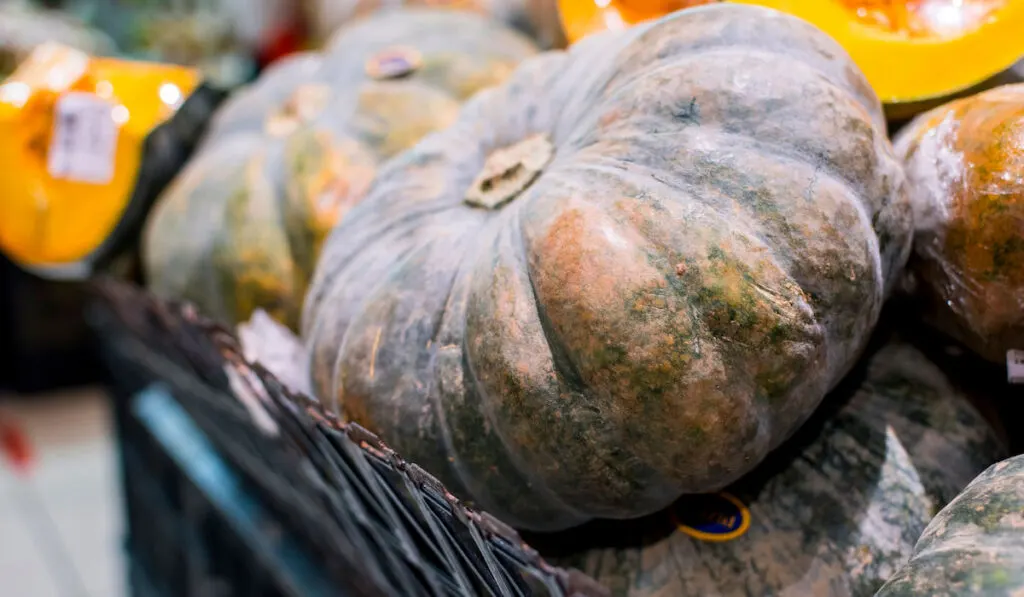
Calabaza squash has dusty green rinds and bright orange, firm flesh.
The squash has a mild flavor and a nutty texture and blends well in sweet and savory dishes. When cooked, it has a slightly sweet taste and is creamy, like butternut squash.
Apart from baking, you can use calabaza squash to fill your pies.
11. ‘Tatume’
‘Tatume’ squash can have a different shape depending on the variety. Some are longer like zucchini, while others are compact and round.
‘Tautume’ is a pale green color with white striping and spots.
‘Tatume’ has a mild flavor and is common in most Latin and Mexican cuisines. You can bake, stuff, grill, saute or roast this squash.
12. Tinda Squash

Tinda squash has a beefsteak tomato-like shape and smooth pale green skin.
The squash is not related to any typical squash, but it’s a fruit of an immature squash family plant. It has creamy white flesh and a mildly sweet flavor, making it a great addition to soups.
13. Round Zucchini
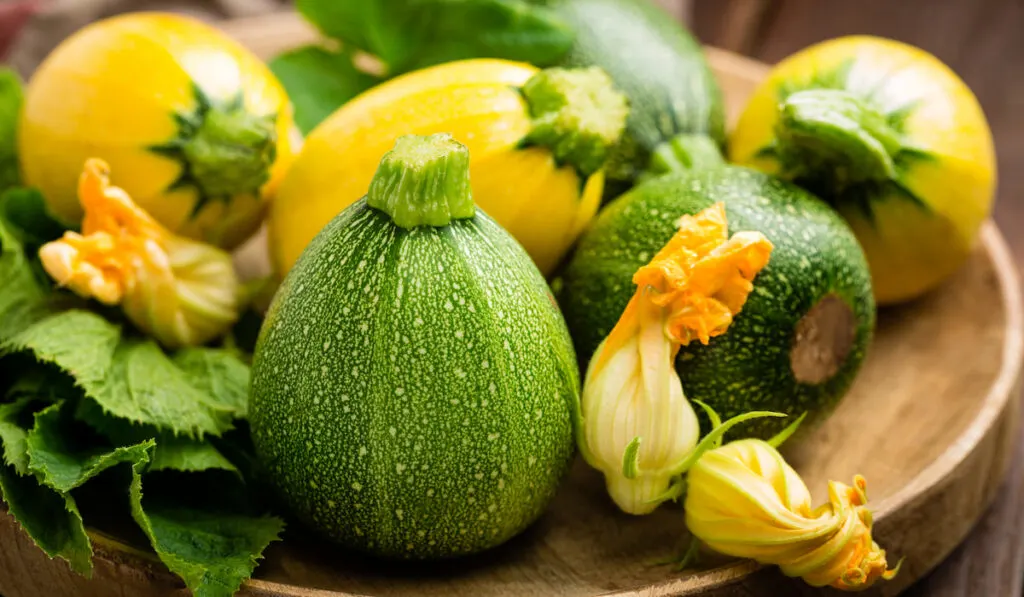
Round zucchini or ‘Eight Ball’ squash has a round shape and a dark green color. Its skin is also covered with green stripes and white freckles.
When cut, the flesh is creamy white. ‘Eight Ball’ squash tastes like ‘Costata Romanesco’ squash, which is rich and buttery.
The shape is the only difference between a regular zucchini and the round one. Its unique shape makes this squash perfect for stuffing. You can also use it for baking.
Round zucchini is in season during summer, although you can find it throughout the year.
14. ‘Delicata’
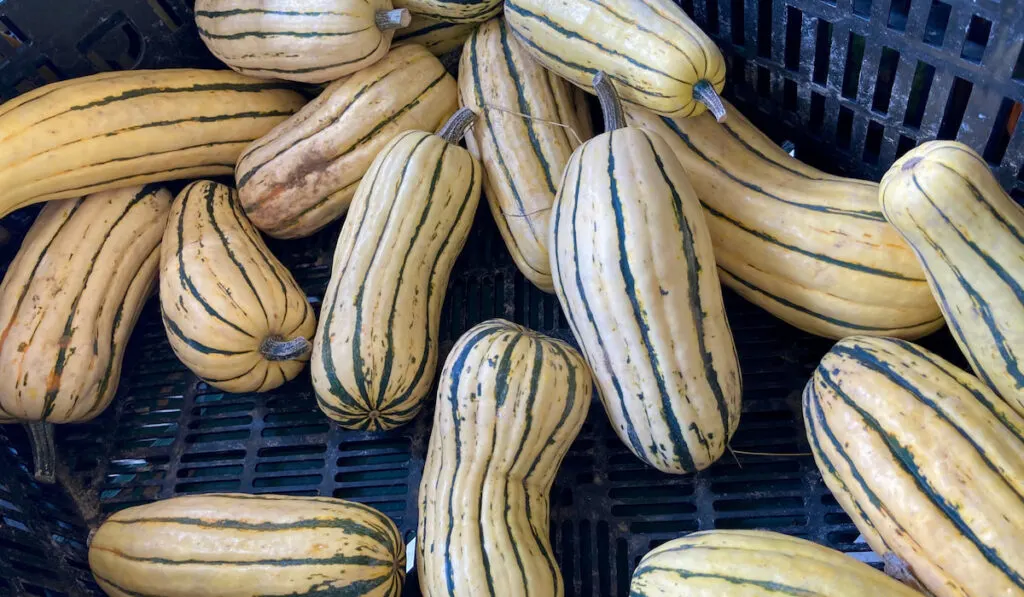
‘Delicata’, or Bohemian squash, has pale green skin with dark green stripes.
Unlike most winter squash, delicata has a thin rind which is also edible. Its flesh has a flavorful taste like a pumpkin, which is why most people refer to it as the sweet potato squash.
15. ‘Tromboncino’ Squash

‘Tromboncino’ squash is originally from Italy and has a curved shape. It also has fewer seeds and is firmer than most squash types.
‘Tromboncino’ squash can be harvested when young and sweet, like a zucchini. Alternatively, you can let it mature for that nutty butternut-like taste.
Its firm flesh and seedless neck make ‘Tromboncino’ squash perfect for grilling. You can also roast, steam, saute this squash or add it to raw salads.
16. ‘Costata Romanesco’
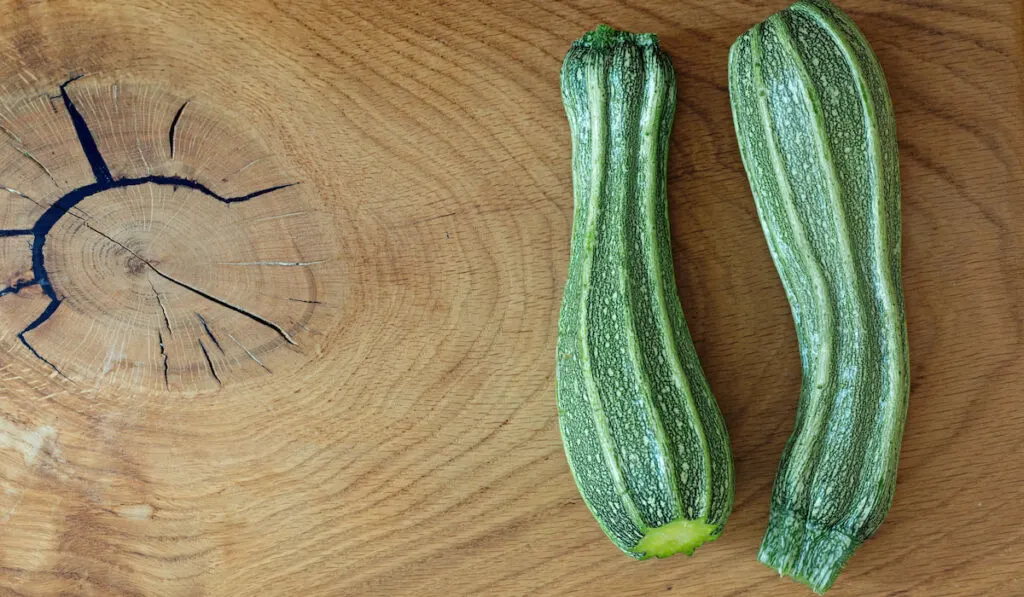
‘Costata Romanesco’ has a bright green color and bold stripes. The Italian heirloom variety is a summer squash that tends to fruit earlier than other varieties.
One unique aspect of this squash is that it retains the summer squash taste, whether small or big.
Its earthy, nutty, and sweet flavor is ideal for hearty soups.
You can also shred it and use it as a fritter or baked goods.
17. ‘Autumn Cup’
The ‘Autumn Cup’ is a cross between kabocha and buttercup squashes.
It has dark green skin and bright yellow flesh with a smooth texture and rich flavor.
Use ‘Autumn Cup’ in soups or roasted with a dash of spices.
Final Thoughts
With our list of the types of green squash, you now have an idea of when to get them and how to use them in your recipes. There is plenty of squash to choose from, and you can always substitute one for a lesser-known variety to learn the differences.
Resources
- https://www.eatthis.com/types-of-squash/
- https://www.gardeningknowhow.com/edible/vegetables/squash/different-summer-squashes-to-grow.htm
- https://growinginthegarden.com/summer-squash-varieties-8-best-types-to-grow/
- https://cleangreensimple.com/article/different-types-of-squash/
- https://www.countryliving.com/gardening/a23457839/types-of-squash/
- https://gardenerspath.com/plants/vegetables/best-summer-squash-varieties/
- https://ucanr.edu/sites/gardenweb/files/
- https://specialtyproduce.com/produce/Calabaza_Squash
